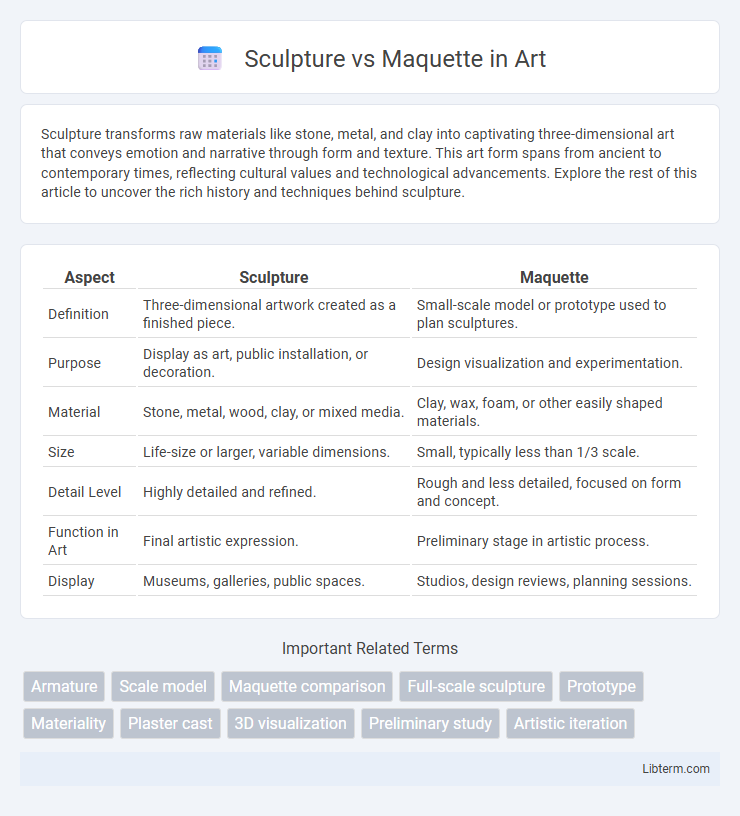Sculpture transforms raw materials like stone, metal, and clay into captivating three-dimensional art that conveys emotion and narrative through form and texture. This art form spans from ancient to contemporary times, reflecting cultural values and technological advancements. Explore the rest of this article to uncover the rich history and techniques behind sculpture.
Table of Comparison
| Aspect | Sculpture | Maquette |
|---|---|---|
| Definition | Three-dimensional artwork created as a finished piece. | Small-scale model or prototype used to plan sculptures. |
| Purpose | Display as art, public installation, or decoration. | Design visualization and experimentation. |
| Material | Stone, metal, wood, clay, or mixed media. | Clay, wax, foam, or other easily shaped materials. |
| Size | Life-size or larger, variable dimensions. | Small, typically less than 1/3 scale. |
| Detail Level | Highly detailed and refined. | Rough and less detailed, focused on form and concept. |
| Function in Art | Final artistic expression. | Preliminary stage in artistic process. |
| Display | Museums, galleries, public spaces. | Studios, design reviews, planning sessions. |
Introduction to Sculpture and Maquette
Sculpture is a three-dimensional art form created by shaping materials such as stone, metal, or clay to produce a finished artwork, often intended for display or public exhibition. A maquette serves as a small-scale model or preliminary version of a sculpture, used by artists to visualize and plan the final piece's composition and proportions. Both concepts are fundamental in the sculptural process, with maquettes providing critical insights that guide the creation of the full-sized sculpture.
Defining Sculpture: Art in Full Form
Sculpture is a three-dimensional artwork created through carving, modeling, or assembling materials such as stone, metal, or clay, embodying the artist's complete vision in its final, full-scale form. Unlike maquettes, which are small-scale preliminary models used to plan and refine design concepts, sculptures present the finished, tangible expression of artistic creativity meant for public display or private collection. The defining characteristic of sculpture lies in its physical presence and interaction with space, light, and perspective to convey meaning and evoke emotional response.
What is a Maquette? Purpose and Process
A maquette is a small-scale model or preliminary version of a sculpture used by artists to visualize and refine their ideas before executing the final piece. Its primary purpose is to explore composition, proportions, and spatial relationships, serving as a three-dimensional sketch that guides the creative process. The process involves sculpting the maquette from materials like clay or wax, allowing for easy modifications and experimentation before progressing to the full-sized sculpture.
Historical Context: Evolution of Sculptures and Maquettes
Sculptures have evolved from ancient stone carvings to complex monumental works, reflecting cultural and technological advancements throughout history. Maquettes, small-scale models of sculptures, gained prominence during the Renaissance as essential tools for artists to visualize and refine their large-scale projects. The transition from maquettes to full sculptures demonstrates the iterative creative process that shaped artistic techniques across centuries.
Materials and Techniques: Sculpture vs Maquette
Sculptures often utilize durable materials such as bronze, marble, or wood, requiring advanced techniques like carving, casting, or welding to create large-scale, detailed artworks. Maquettes are typically made from clay, wax, or foam, allowing artists to quickly model and experiment with form and composition on a smaller scale. The maquette serves as a preliminary tool in the sculpting process, facilitating adjustments before committing to the final materials and techniques used in the full-scale sculpture.
Scale and Detail: Comparing Artistic Approaches
Sculptures are large-scale, finished artworks showcasing refined detail and texture designed for public display or private collections. Maquettes are smaller-scale models used by artists to experiment with composition, form, and proportions before executing the final sculpture. The difference in scale directly influences the level of detail, with sculptures exhibiting intricate features while maquettes emphasize conceptual structure and spatial relationships.
Role in Artistic Workflow: Maquette as a Blueprint
A maquette serves as a detailed three-dimensional blueprint in the artistic workflow, allowing sculptors to experiment with form, proportion, and composition before creating the full-scale sculpture. This small-scale model facilitates adjustments and refinements, ensuring the final sculpture achieves the desired aesthetic and structural integrity. Sculptures are the finalized artworks, often larger and more complex, realized after thorough planning using maquettes.
Display and Function: Final Piece vs Prototype
Sculptures serve as the final artistic expression, designed for permanent display in galleries, museums, or public spaces, showcasing detailed craftsmanship and intended for long-term appreciation. Maquettes act as prototype models, allowing artists to experiment with form, scale, and composition before creating the final piece, often smaller and less refined. Their primary function is to guide the sculpting process, assist in client approvals, or test structural feasibility rather than serve as display objects.
Notable Artists and Famous Works
Notable sculptors such as Auguste Rodin and Henry Moore are renowned for their monumental sculptures like Rodin's "The Thinker" and Moore's "Reclining Figure," which showcase mastery in large-scale three-dimensional art. In contrast, maquettes serve as preliminary models, with artists like Michelangelo creating detailed maquettes for works such as the statue of David, enabling refinement before full-scale execution. These smaller-scale maquettes are crucial in the artistic process, bridging conceptual design and final sculpture craftsmanship.
Conclusion: Choosing Between Sculpture and Maquette
Choosing between sculpture and maquette depends on the project's scope and purpose; sculptures serve as finished, full-scale art pieces, while maquettes function as detailed, smaller-scale models for planning and visualization. Sculptures demand more time, materials, and skilled craftsmanship, making them ideal for public installations and permanent displays. Maquettes provide flexibility for experimentation and client presentations, helping artists refine concepts before committing to the final sculpture.
Sculpture Infographic

 libterm.com
libterm.com